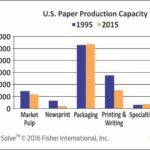The adoption of sustainable business practices is increasingly being seen a strategic means by which industries can address emerging risks to their business, with many companies recognizing its centrality to long-term growth.

The same holds true for the paper industry, which is being faced with its own unique set of challenges. Of particular concern is the rising demand for limited resources that paper production is reliant on, which presents tangible business risks. Increasing costs of inputs, restricted access to markets associated with environmental concerns around rising tropical deforestation, and high levels of water and energy consumption and pollution are some of the mounting risks being faced by this industry.
Thus, from the point of view of the paper industry, sustainable management of the natural resources on which it relies is critical, especially considering that it tends to have a heavy environmental footprint. In terms of its forest footprint, 40% of the annual wood harvested from forests globally is processed to manufacture paper and paperboard. Further, in terms of its climate footprint, according to EIA, the pulp and paper sector represents about 6% of global industrial energy use. Water is also an important input used in the papermaking industry, which accounts for more than 90 per cent of the total inputs used during pulp and paper production. In fact, it is estimated that the printing and writing paper industry on average uses between 2-13 litres of water to manufacture a single A4 sheet (depending on quality).
In the context of India, one of the top producers and consumers of paper in the world, it is particularly important to examine the overall footprint of this industry. According to the FAO forestry statistics of 2014, India alone produced and consumed 3% of the global volumes. Out of the forest-based fibre procured to furnish the country’s paper consumption, majority of wood pulp imports into India come from ecologically important landscapes and habitats in Sumatra, Borneo, New Guinea which, according to WWF’s Deforestation Fronts analysis, are facing severe forest loss and degradation primarily as a result of the growing demand for pulpwood. Tackling deforestation is also critical from the point of view of mitigating regional and global climate change – deforestation has been estimated to be the second largest contributor to carbon emissions. In terms of water, Indian pulp and paper mills are estimated to be among the most water-intensive in the world, which is striking particularly since India’s 20 major river basins are already water-stressed and are predicted to move towards extreme water scarcity by 2050.
There is, therefore, a need for Indian paper manufacturers to develop a deeper understanding of their supply chains and operations and accordingly identify what can be done to address their respective risks and ‘problem areas’. There is also a strong business case for addressing these risks, thereby turning them into opportunities. For paper manufacturers, steps leading to the reduction of their footprint across their operations as well as the sustainable management of the natural resources that are central to their supply chains can help them to:
a. Secure raw material access.
b. Improve their profitability and sustain long-term growth.
c. Differentiate their brand and aid in recognition.
d. Ensure continued market access as regulatory and consumer demands evolve.
A critical first step is therefore developing an understanding the forest, water and climate footprint embedded within the core of a paper manufacturer’s operations.
Where to start?

Self-assessment of a manufacturer’s performance around some key sustainability parameters like water, energy and raw materials is a good start. Transparent reporting of this performance can also inform a manufacturer’s large buyers and industrial users’ purchasing decisions and ensure that they are socially and environmentally responsible.
To this end, WWF, through its international network, has developed a number of tools and frameworks to help companies (both producers and buyers of forest-based products) on their sustainability journey based on learning across different geographies. Globally, major brands like IKEA, Unilever, Kimberly-Clark and many others have used these frameworks to assess their performance around the key sustainability parameters of water, energy and raw material sourcing. Transparency tools Check Your Paper (CYP), Environmental Paper Company Index (EPCI) as well as robust international certification systems such as Forest Stewardship Council (FSC) are globally accepted by responsible brands as effective means to guide their work, authenticate sustainability claims, differentiate and enhance brand image, and promote their achievements.
How these tools work.
‘Check Your Paper’ (CYP) is a tool that assists paper producers and buyers to assess performance around the key sustainability parameters of water, energy and raw material sourcing.
High ratings are given to products which use responsibly-sourced virgin fibre, recycled fibre or agricultural waste as raw material, and reduce emissions, waste and water pollution in their manufacturing, allowing buyers to assess their procurement choices from a sustainability perspective.
High-performing companies with superior sustainability performance across any of their product lines or brands can use these tools to showcase their achievements and also achieve market differentiation through brand-endorsed statements and ratings, which can be used on off-product collateral and in formal business communication.
DIY!
The ‘Environmental Self-check’ feature of CYP allows paper manufacturers to carry out an internal assessment to highlight gaps in various aspects of performance for internal strategy development.
The five online steps can be completed confidentially and scores used without any cost. Results may be published when a company chooses, giving an opportunity to highlight their achievements.
Converters and printers can also use CYP criteria as a reference point to inform their own screening standards for suppliers.
Multi-business Indian conglomerate, ITC chose CYP to assess the sustainability aspect of its paper production. “With its simple and accessible features, WWF’s Check Your Paper tool supported our endeavour to enrich the country’s environmental capital while generating significant sustainable livelihood opportunities. The CYP measure reflects our leadership in sustainability and transparent reporting of our performance”, said Mr. S.N. Venkataraman, Divisional Head – Marketing at ITC-PSPD.
As a scoring measure, each paper product is given a rating of 0 – 5 stars on its forest performance, climate performance and water performance, where third-party certification is taken into consideration as a part of the assessment criteria.
Paper companies like ITC-PSPD and TNPL have taken this assessment even further using a more comprehensive tool on transparency called the ‘Environmental Paper Company Index’ (EPCI). This looks in greater detail at environmental aspects of a company’s policies and targets, as well as the environmental performance of its production across different paper product categories.
Evaluations are highly detailed and the final scoring reveals where a company stands against average and maximum scoring companies in the same product category. In this way, companies can use EPCI to assess their relative performance, which can help with benchmarking and internal assessments. Using this benchmarking to gauge where a company falls with regard to global best practices, and to then set internal targets accordingly, will help a company to be more competitive in a developing Indian economy as well as gain better access to more evolved export markets.
Moving forward
As markets open up to global competition and as awareness levels about sustainability concurrently rise, it becomes increasingly important for key stakeholders in value chains to understand and adopt sustainable business practices.
External stakeholders like financiers, NGOs and end-consumers are also becoming direct influences. It is relevant to note that financial institutions are also looking at credible business responsibility reporting to assess financial risk profiles and determine lending criteria. Here, assessment and transparency tools like CYP and EPCI can also provide an easy solution in terms of benchmarking, profiling and reporting on the progress made by a company on managing resources and footprint. Moreover, such practices provide business with a larger opportunity to contribute to ecological benefits of preventing forest degradation and conserving biodiversity.
References:
- http://www.fao.org/forestry/44134-01f63334f207ac6e086bfe48 fe7c7e986.pdf
- http://www.iiasa.ac.at/web/home/research/Flagship-Projects/ Global-Energy-Assessment/GEA_Chapter8_industry_lowres.pdf
- http://awsassets.wwfindia.org/downloads/water_stewardship_report_final_edited_1.pdf
- http://waterfootprint.org/media/downloads/Report46-WaterFootprintPaper_1.pdf
- http://www.fao.org/3/a-i3710e.pdf
- http://wwf.panda.org/about_our_earth/deforestation/forest_ sector_transformation/pulp_and_paper/
- Bastos Lima, M.G., Braña-Varela, J., Kleymann, H., Carter, S. (2014). The Contribution of Forests and Land Use to Closing the Gigatonne Emissions Gap by 2020. WWF-WUR brief no.2.
- CSE, 2004, Water and Pollution Stress – Green rating of Indian pulp and paper industry
- http://awsassets.wwfindia.org/downloads/water_stewardship_ report_final_edited_1.pdf



